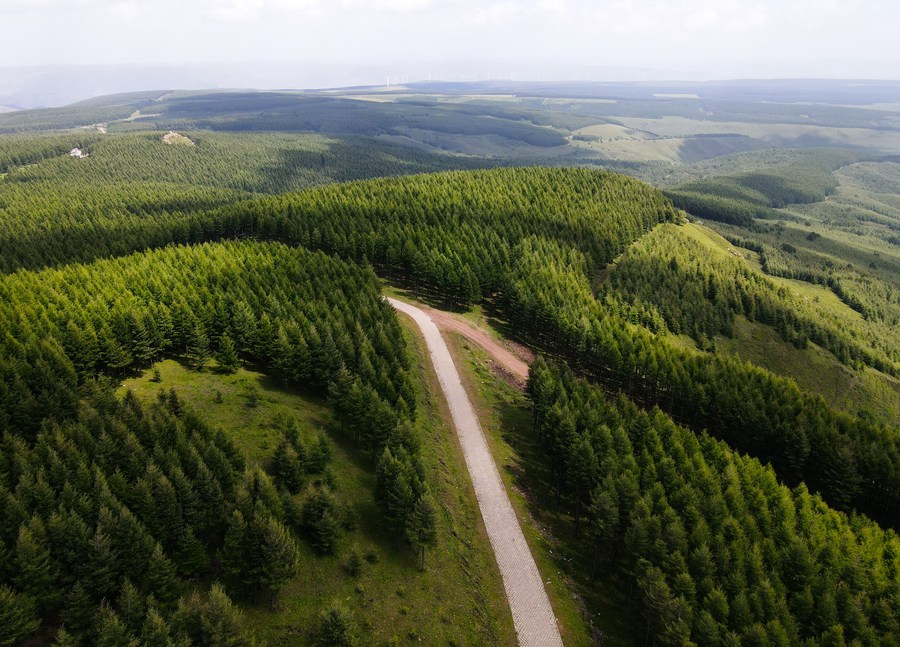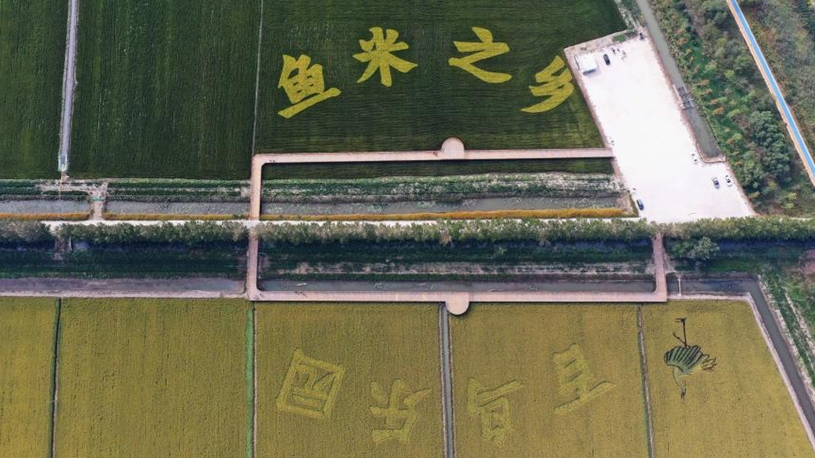
Aerial photo taken on Aug. 22, 2021 shows the scenery of Saihanba forest farm in north China's Hebei Province. (Xinhua/Jin Haoyuan)
BEIJING, Oct. 2 (Xinhua) -- China ranks first globally in the area of planted forests and forest coverage growth, contributing a quarter of the world's new forest area in the past decade.
The secret behind the rapid growth of China's green landscape lies in its large-scale greening campaign, including conserving existing green ecosystems, adding new forests, grasslands, and wetlands, as well as fighting desertification.
According to the National Forestry and Grassland Administration, the accumulative afforestation area reached 960 million mu (64 million hectares) over the past 10 years, while 165 million mu of grassland was improved, and more than 12 million mu of wetlands were added or restored.
BUILDING "GREEN GREAT WALL"
From the tree planting programs to the world's largest artificial plantation Saihanba mechanized forest farm, China has been striving to build a solid "Green Great Wall" to protect the ecological environment.
China designated March 12 as National Tree Planting Day in 1979, and Chinese citizens voluntarily planted approximately 78.1 billion trees from 1982 to 2021 across the vast country, official data showed.
The COVID-19 epidemic did not keep municipalities nationwide away from tree planting. Some cities instructed volunteers to keep "a safe distance" when planting trees, while others assembled small groups of volunteers to plant trees on behalf of hundreds of public-spirited residents.
Besides the offline planting activities, the country's internet-based greening campaign "Ant Forest" allows residents to adopt trees by paying due contributions online or garner enough credits by performing low-carbon activities like taking public transportation in exchange for a real tree to be nurtured in their names.
By the end of May, more than 550 million people had participated in the project to plant over 200 million trees, reducing exhaust equivalent to 12 million tonnes of carbon dioxide.
In recent years, China has built a protected area system with national parks as the mainstay, supported by nature reserves and supplemented by nature parks.
Saihanba, in north China, was once a royal hunting ground and degraded into an area of barren wilderness. Thanks to consistent efforts by three generations of Saihanba foresters, it has now become a national forest park and nature reserve with a total forest landscape of 1.15 million mu.
The Saihanba mechanized forest farm was granted the 2021 Land for Life Award of the national category at a ceremony held during the Kubuqi International Desert Forum.
As a "blue carbon sink," mangrove is an important part of carbon sequestration by vegetation. The restoration of mangrove wetlands in the coastal area of Shenzhen ensures that the total area of mangroves will gradually expand, reversing the trend of ecological function degradation of the mangrove wetland system.
Last June, the restoration project was selected as a typical practice case jointly issued by the Ministry of Natural Resources and the International Union for Conservation of Nature.
GREEN TO GOLD
China's efforts to expand its forest area and improve forest quality have increased the ecosystem's carbon sink, contributing to achieving the country's target of peaking CO2 emissions by 2030 and achieving carbon neutrality by 2060.
A study published in the internationally renowned academic journal Nature found that from 2010 to 2016, China's terrestrial ecosystems absorbed approximately 1.11 billion tonnes of carbon per year, absorbing 45 percent of human carbon emissions during the same period.
China's reforestation efforts also improved biodiversity. In the mangrove nature reserve on the coast of Shenzhen, migratory birds, including egrets, gulls, and geese, enjoy their leisure in the sun on the beach.
Thick forests have also become a substantial source of revenue for locals. Over the years, Saihanba Forest Farm has developed its economy by relying on tourism, tree planting, and wind power generation. The greening sectors bring in over 600 million yuan (about 84.39 million U.S. dollars) in revenue annually, data showed.
Forest parks are popular attractions of tourism and have become a third pillar of the forestry industry. During the 13th Five-Year Plan period (2016-2020), China's forests attracted 7.5 billion visitors, creating a comprehensive social output value of 6.8 trillion yuan.
Looking to the future, China will continue to blaze an eco-friendly trail for the world's green development, with the aim of increasing the forest cover to 26 percent by 2035 and becoming a leading country in forestry by 2050. ■












